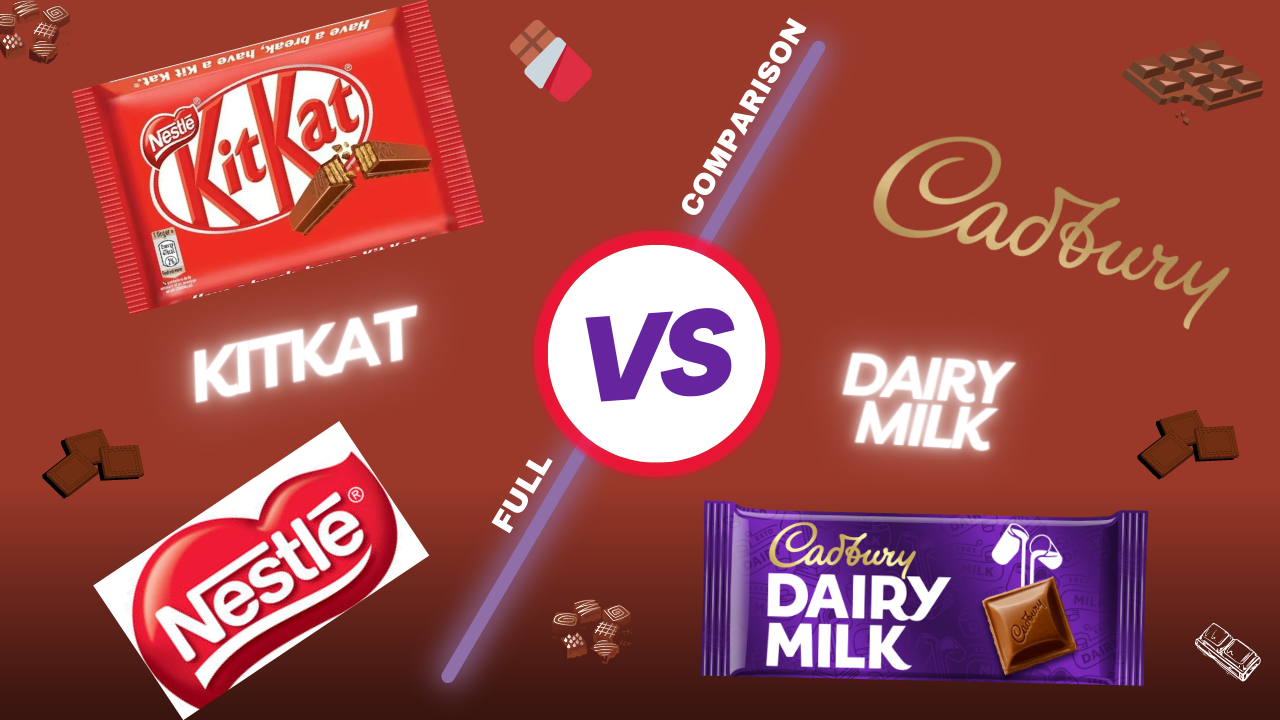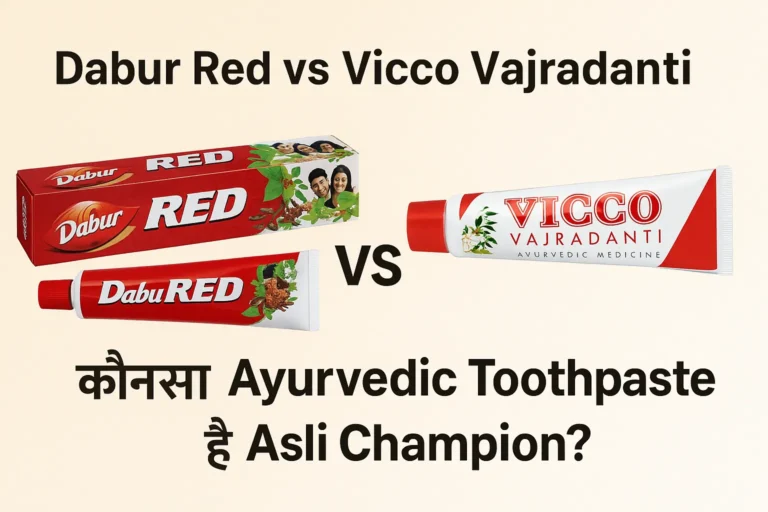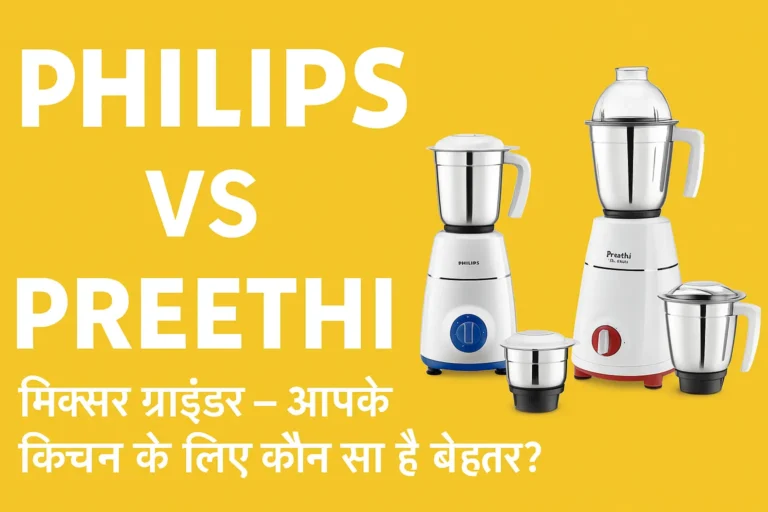Chocolate, a delicious delicacy loved by people of all ages and cultures, has captivated the hearts of people for centuries. With its rich history dating back to ancient civilizations, chocolate has evolved from a treasured ceremonial drink to a unique indulgence enjoyed in various forms around the world. Derived from the cocoa bean, this heavenly delight is woven into the fabric of our lives, delighting our taste buds and instilling a feeling of comfort and happiness with every bite.
Have a Comparison Table :-
NAMES | KITKAT | DAIRY MILK |
LAUNCHED | 1935 | 1905 |
COMPANY | NESTLE | CADBURY |
ORG COUNTRY | ENGLAND (U.K) | BIRMINGHAM (U.K) |
COLOURS | RED | DARK BLUE |
HEADQUATERS | CALIFORNIA (U.S) | UXBRIDGE (U.K) |
FOUNDER | ROWNTREE’S OF YORK | GEORGE CADBURY JR. |
MARKET | WORLD WIDE | WORLD WIDE |
1. Introduction : Kitkat Vs Dairy Milk
- Indulging in chocolate is a universally loved experience, and two iconic chocolate brands have cemented their place in the hearts of chocolate lovers across the globe. KitKat and Dairy Milk , with their unique taste and pleasing texture, have enthralled the taste buds and become the epitome of pure joy. In this article, we embark on a delectable journey to compare and contrast these beloved chocolate bars. From their origins and distinctive features to their popularity and market presence, we’ll take a look at what makes KitKat and Dairy Milk such enduring favorites. So, grab your favorite chocolate bar, and let’s enjoy the sweet exploration of KitKat vs Dairy Milk.
2. History and Origins
KitKat :
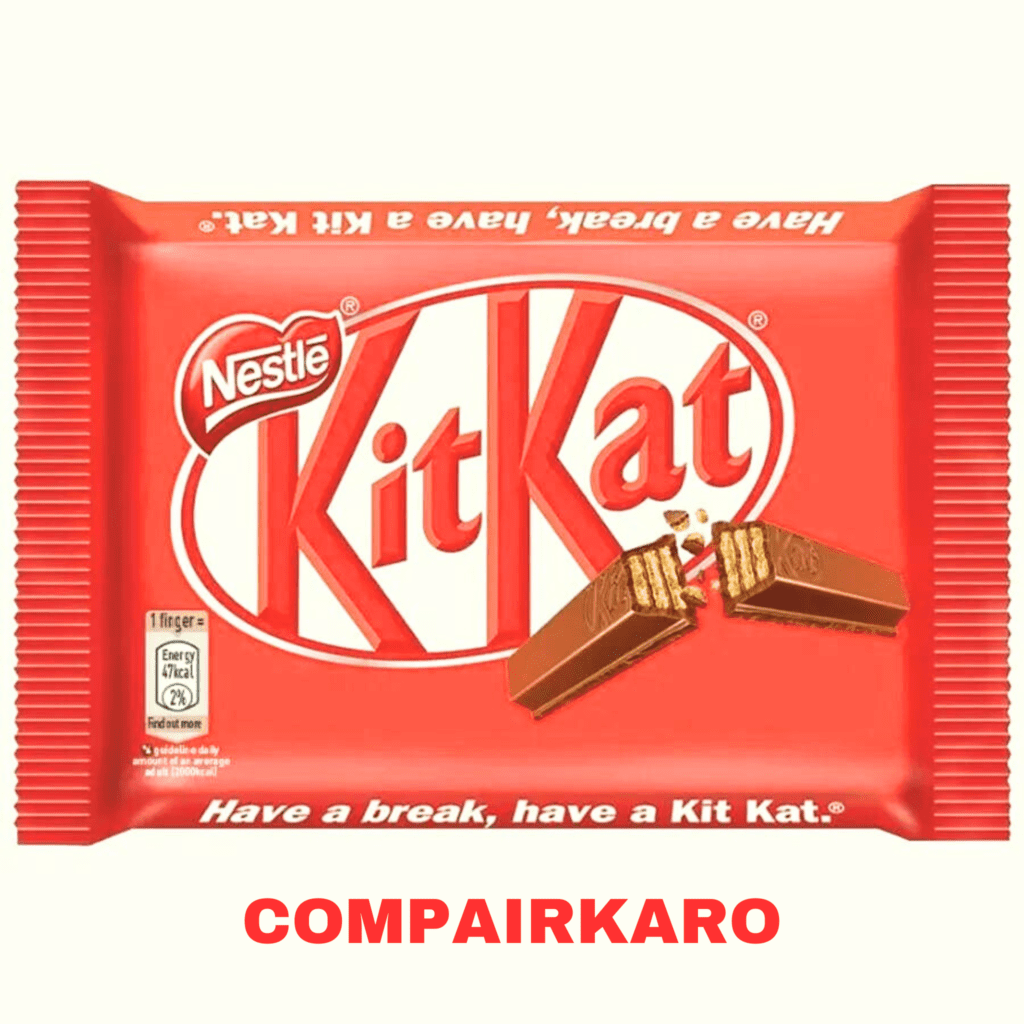
- KitKat, the famous chocolate wafer bar, has a fascinating history dating back to the early 1930s. The confectionery masterpiece was produced by Rowntrees of York, a British chocolatier founded in the 19th century by Henry Isaac Rowntree. In 1935, Rowntree launched “KitKat Chocolate Crisp” in the United Kingdom, introducing a new concept that combined layers of crisp wafers with a coating of smooth milk chocolate.
- During World War II, KitKat grew in popularity as it became part of British soldiers’ rations, providing an enjoyable and comforting treat amid the hardships of war. After the war, chocolate bar production expanded to other countries, including Canada and Australia, further strengthening its global appeal.
- The iconic “Have a break, have a KitKat” slogan was introduced in the late 1950s, and it soon became synonymous with taking a break and enjoying a moment of pure indulgence. Over the years, KitKat has made several innovations, introducing new flavors and limited editions, and attracting consumers with its ever-expanding range.
Dairy Milk :
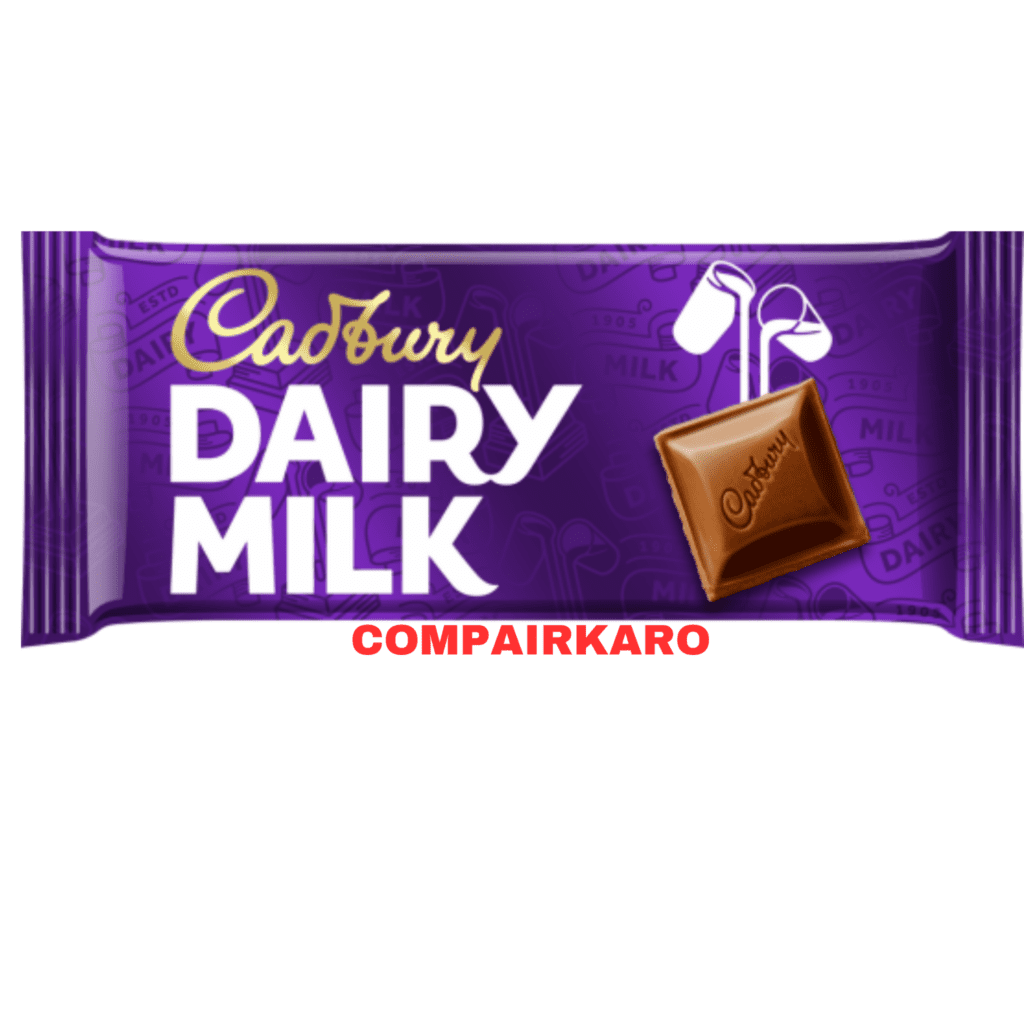
- Dairy Milk, the beloved milk chocolate bar, has a history dating back to 1905. It was introduced by Cadbury, a British confectionery company founded by John Cadbury in the early 19th century. Cadbury Dairy Milk was the company’s first milk chocolate bar, and had a higher proportion of milk than the cocoa content prevalent in other chocolates at the time.
- Dairy Milk’s inspiration came from a desire to create a smooth, creamy chocolate bar that would appeal to a wide audience. The name “Dairy Milk” was chosen to highlight the inclusion of fresh milk, making it a premium and luxurious dish.
- Cadbury’s Dairy Milk has gained immense popularity over the decades and has become a true icon of British confectionery. Its distinctive purple packaging and famous “glass and a half” slogan, emphasizing the liberal use of milk in the recipe, further contributed to its appeal.
- The success of Dairy Milk prompted Cadbury to expand its production to various countries, making it a global sensation among chocolate lovers around the world.
KitKat and Dairy Milk both have a rich history filled with innovation and a commitment to delivering an enjoyable chocolate experience. Their unique stories of creation and journey to become iconic chocolatiers have cemented their place in the hearts of chocolate lovers everywhere.
3. Flavors and Varieties
KitKat :
- KitKat comes in an array of delicious flavors and varieties that continue to woo chocolate connoisseurs across the globe. In addition to the classic milk chocolate version, KitKat offers an assortment of creative flavors that cater to diverse tastes. Some popular flavors include:

- Dark Chocolate: For those who relish the rich intensity of dark chocolate, KitKat offers a velvety and delicious dark chocolate variant.
- White Chocolate: The creamy and smooth white chocolate version appeals to those seeking a lighter and sweeter taste.
- Matcha Green Tea: Adopting Japanese influences, KitKat introduced the Matcha Green Tea flavor, which balances the sweetness of chocolate with the earthy flavor of matcha.
- Ruby Chocolate: Taking advantage of the unique ruby cocoa bean, KitKat ventures into the world of pink-colored chocolate with a subtle berry-like flavor.
- Fruity: KitKat has experimented with fruity flavors such as orange, strawberry and lemon, providing a refreshing twist to the classic wafer bar.
- Limited Edition: KitKat is known for its flashy limited-edition releases, which often celebrate seasonal occasions or cultural events. Some regional variations include flavors such as Wasabi (Japan), Cheesecake (United Kingdom), and Chili Mango (Australia).
Dairy Milk :
- Cadbury Dairy Milk has also adopted a variety of flavors to complement its signature milk chocolate variety. In addition to classic milk chocolate, some notable dairy milk flavors include:
- FRUIT & NUTS: The delightful combination of rich milk chocolate with plump raisins and crunchy almonds provides a delightful contrast of textures and flavors.
- Caramel: The smooth and buttery caramel filling adds an extra layer of enjoyment to the velvety milk chocolate.
- Oreo: Collaborating with the renowned cookie brand, Cadbury Dairy Milk introduced a mix of chocolate and Oreo cookie pieces, which provides a delicious crunch.
- Mint Crisp: This refreshing flavor combines creamy milk chocolate with crisp mint-flavored pieces, creating a minty chocolate feel.
- AMAZING CREATIONS: An imaginative range of Dairy Milk Bars with a variety of exciting inclusions like jelly beans, popping candy and cookie pieces, offering a delightful surprise with every bite.
- Regional Variations: There are regional variations in dairy milk, with each country introducing a flavor specific to local tastes. For example, Cadbury Dairy Milk in India offers flavors such as Silk Silk Bubbly, Silk Oreo and Silk Fruit & Nut.
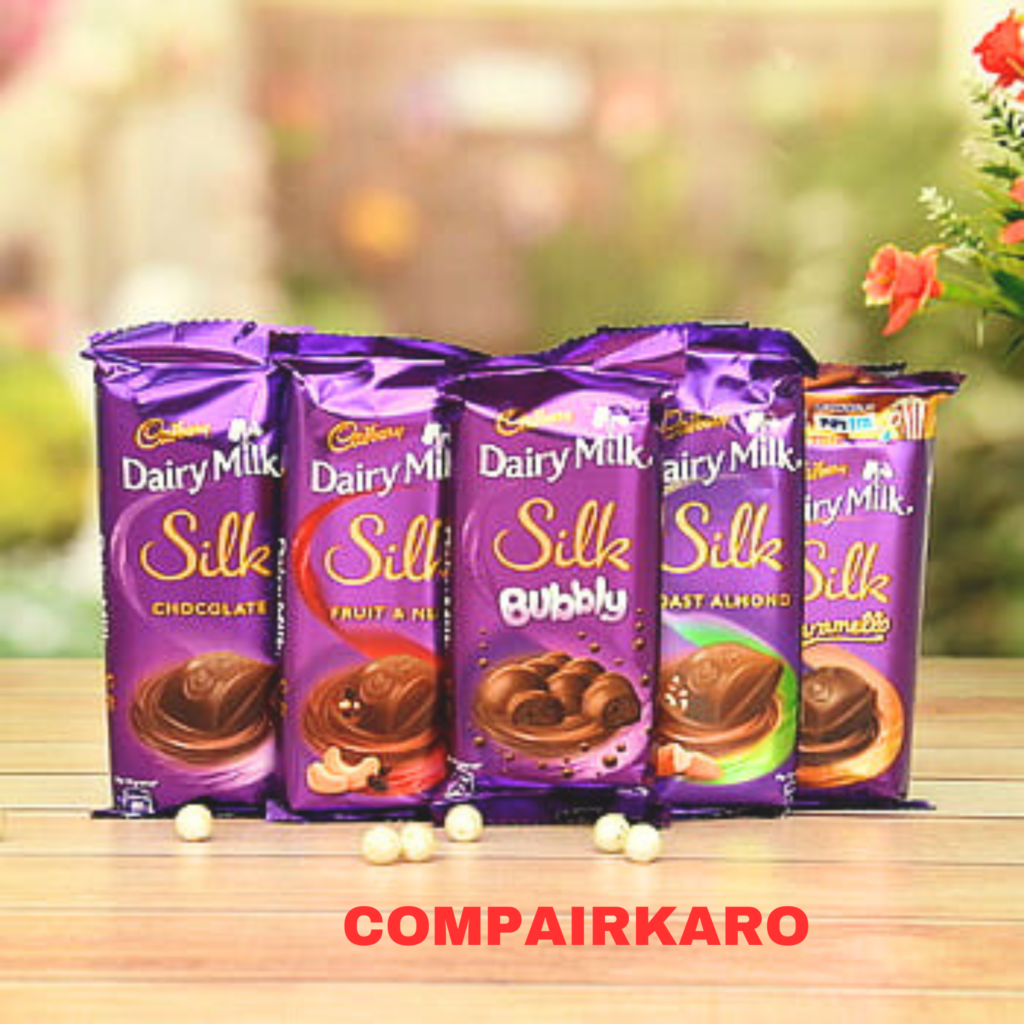
Both KitKat and Dairy Milk continue to innovate creative flavors and limited-edition releases, meeting global and regional preferences. Whether you crave the wafer crunch of KitKat or the creamy richness of dairy milk, these delicious chocolate bars offer a variety of flavors to satisfy every chocolate lover’s cravings.
4. Taste and Texture
KitKat :
- The taste and texture of KitKat provide a delightful contrast that sets it apart as a unique chocolate bar. The first bite reveals a satisfying snap as the crisp layers of the wafer break down, creating a light and airy feel on the palate. The delicate crunch of the wafer matches perfectly with the smooth and creamy milk chocolate coating, resulting in a balanced combination of textures. Milk chocolate envelops the wafer, providing a sweet and comforting flavor that isn’t too rich, making it a perfect treat for both kids and adults. The thinness of the wafer layers ensures that the chocolate is not overwhelming, allowing the individual flavors to shine through. Splitting the KitKat into individual fingers adds to the interactive eating experience, inviting you to break off a piece with each bite. This unique feature encourages the bar to be shared or savored with one finger at a time, making it a perfect companion for moments of relaxation or social gatherings.
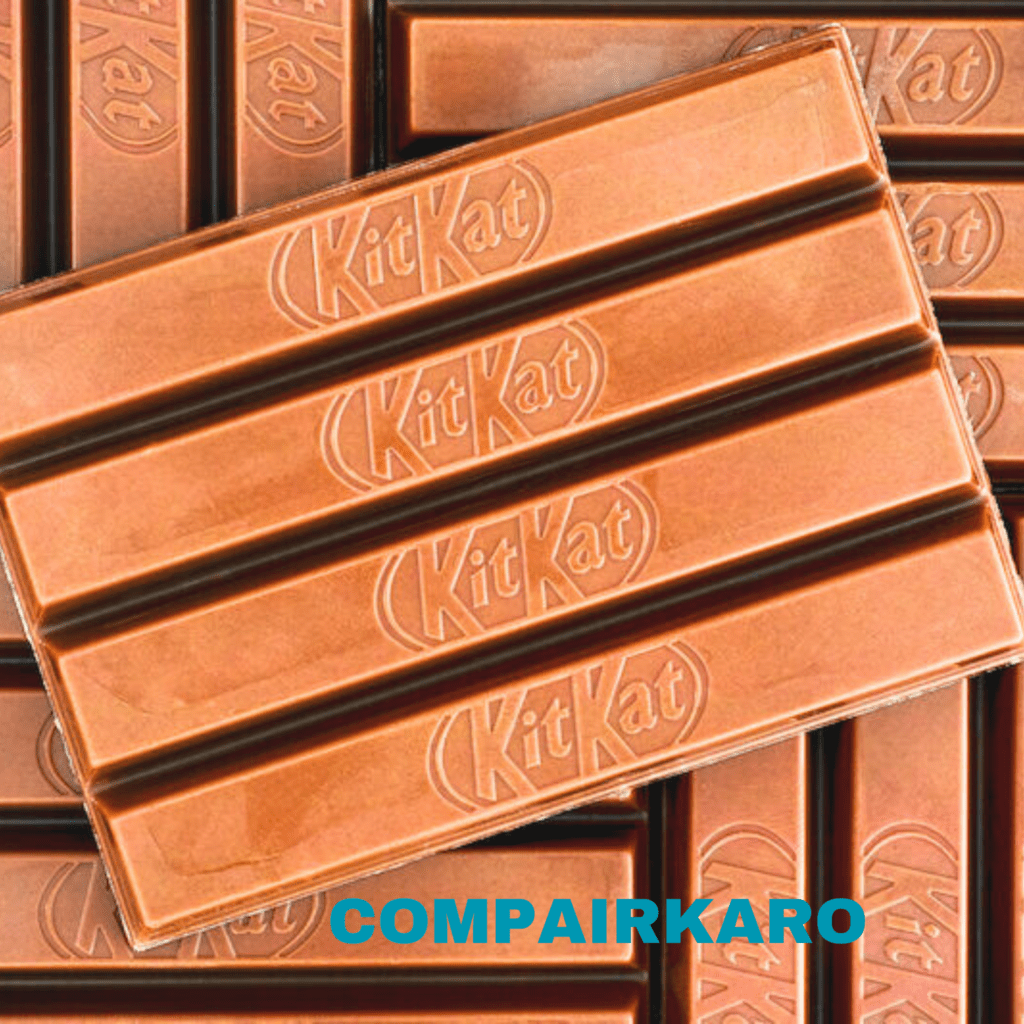
Dairy Milk :
- Cadbury Dairy Milk has a smooth and creamy texture that defines its uniqueness. Milk chocolate melts slowly in the mouth, enveloping the taste buds in a velvety embrace. With a more pronounced sweetness than KitKat, the rich cocoa flavor is beautifully balanced with the creaminess of milk. Dairy milk has a thicker consistency, providing a more delicious mouthfeel that lasts on the palate. The creaminess of chocolate adds to the comfort and indulgence associated with this iconic treat, making it a favorite for moments of pure relaxation and indulgence. Each bite of Dairy Milk evokes a sense of belonging and nostalgia, bringing back warm childhood memories. The simplicity of the solid chocolate bar allows the flavor to take center stage, making it a beloved classic that is loved by chocolate connoisseurs and general consumers alike.
Overall Eating Experience :
- KitKat and Dairy Milk provide uniquely enjoyable eating experiences, each catering to different preferences. The delicate layers of wafers and the interactive nature of breaking individual fingers contribute to KitKat’s fun and light-hearted appeal. It’s an on-the-go snack that provides a quick and enjoyable pick-me-up. Dairy milk, on the other hand, delights the senses with its velvety smoothness and classic chocolate flavor, making it a comforting treat for moments of relaxation and self-indulgence.
- KitKat’s unique qualities lie in its light and crisp texture, while Dairy Milk mesmerizes with its creamy and nostalgic richness. Whichever chocolate bar you choose, both KitKat and Dairy Milk have earned their places as iconic favorites, providing moments of immense joy and satisfaction with each delicious bite.
5. Ingredients and Nutrition:
KitKat :
When it comes to ingredients and nutritional information, KitKat boasts of a combination of nutritious ingredients that contribute to its delicious taste. The main components of a standard KitKat bar include:
- Wafer: Made from a mixture of wheat flour, sugar, vegetable oil and leavening agents, the wafer layers provide a light and crispy texture.
- Milk chocolate: The outer coating of a KitKat consists of smooth milk chocolate, which usually contains milk solids, cocoa solids, cocoa butter, sugar, and other emulsifiers to create its creamy consistency.
Now let’s get into the nutritional information in detail. Please note that values may vary depending on the area and size of the bar:
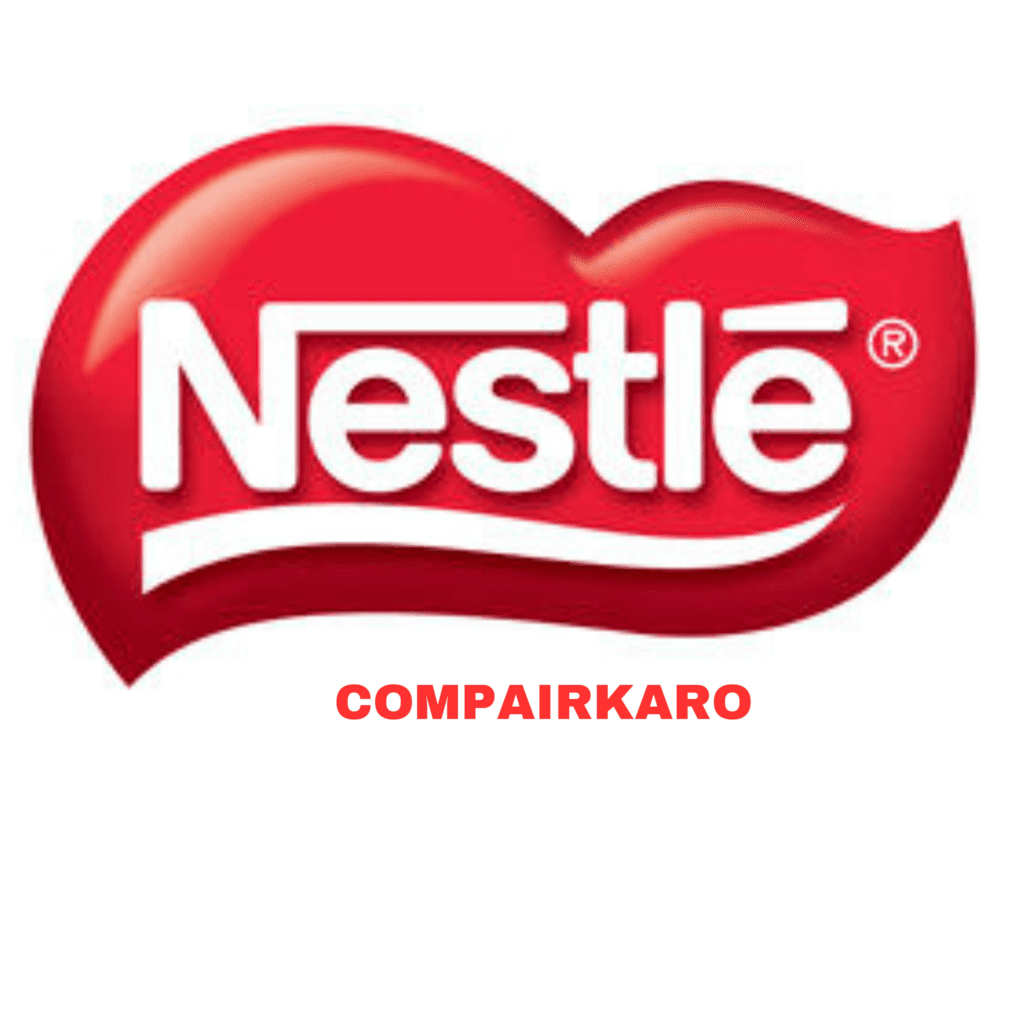
- Calories: A typical four-finger KitKat bar (45 grams) contains approximately 220-230 calories.
- Fat content: The same serving size typically contains about 11–13 grams of fat, with saturated fat being the most significant component.
- Sugar level: KitKat contains about 12-14 grams of sugar per bar, which contributes to its sweet taste.
Dairy Milk :
Dairy milk, known for its smooth and creamy texture, includes a set of ingredients that create its distinctive taste:
- Milk Chocolate: The primary ingredient in dairy milk is its milk chocolate, which is prepared from milk solids, cocoa solids, cocoa butter, sugar, and emulsifiers.
- Again, the nutritional information provided here is for a standard Dairy Milk bar and may vary depending on the specific product:
- Calories: A typical 49-gram Dairy Milk bar contains approximately 240–250 calories.
- Fat content: The same serving size typically contains about 13–15 grams of fat, including saturated fat.
- Sugar level: Dairy milk has a slightly higher sugar content as compared to KitKat, with around 25-27 grams of sugar per bar.
Compare:
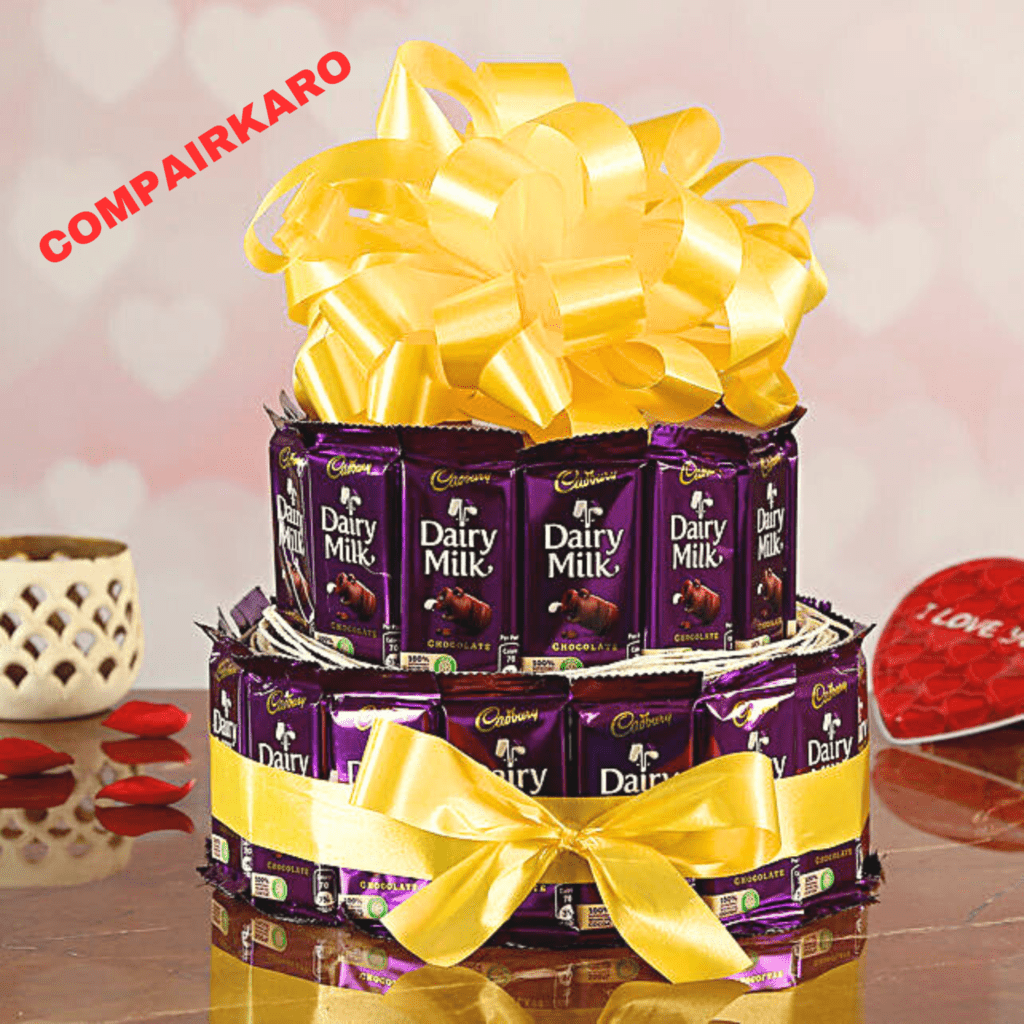
When comparing the two chocolate bars, it is clear that KitKat generally has slightly lower calorie counts and sugar content than Dairy Milk. However, dairy milk has slightly more fat, which contributes to its creamier texture and richer flavor.
Both chocolate bars are delightful treats that can be enjoyed in moderation as part of a balanced diet. It’s important to be mindful of portion size and consider individual dietary preferences and needs when choosing between these two iconic chocolates.
Readers interested in calorie-conscious alternatives may find KitKat a favorable choice, while those seeking a more flavorful and creamy experience may lean toward Dairy Milk. Ultimately, choosing between these beloved chocolates comes down to personal taste and the pleasure each bar brings with each delightful bite.
People also Read :- Mount Everest Vs Burj Khalifa
6. Branding and Packaging
KitKat :
- KitKat’s branding and packaging have played a significant role in establishing its iconic status around the world. The brand’s visual appeal is characterized by its distinctive red packaging, which is instantly recognizable on store shelves. The bright red color evokes a sense of energy and excitement, symbolizing the joyful and euphoric experience of enjoying KitKat Break.
- The packaging design features a bold and prominent logo with the letter “K” in front, as well as the brand name “KitKat”. This simple yet effective logo has become synonymous with the brand and easily connects with the product. Additionally, the image of a four-finger chocolate bar on the package provides an immediate visual representation of what consumers can expect inside.
- Furthermore, KitKat’s breakable format has been cleverly incorporated into the packaging design. The individual fingers of the chocolate bar are presented as separate compartments, creating a sense of interactivity and inviting consumers to take a bite, reinforcing the brand’s “Have a Break, Have a KitKat” slogan.
The overall consumer experience is enhanced by the user-friendly and convenient packaging of KitKat. Each finger is individually wrapped, allowing for portion control and easy sharing. The vibrant red color and familiar branding evoke a sense of nostalgia and comfort, making KitKat an enjoyable and accessible treat for people of all ages.
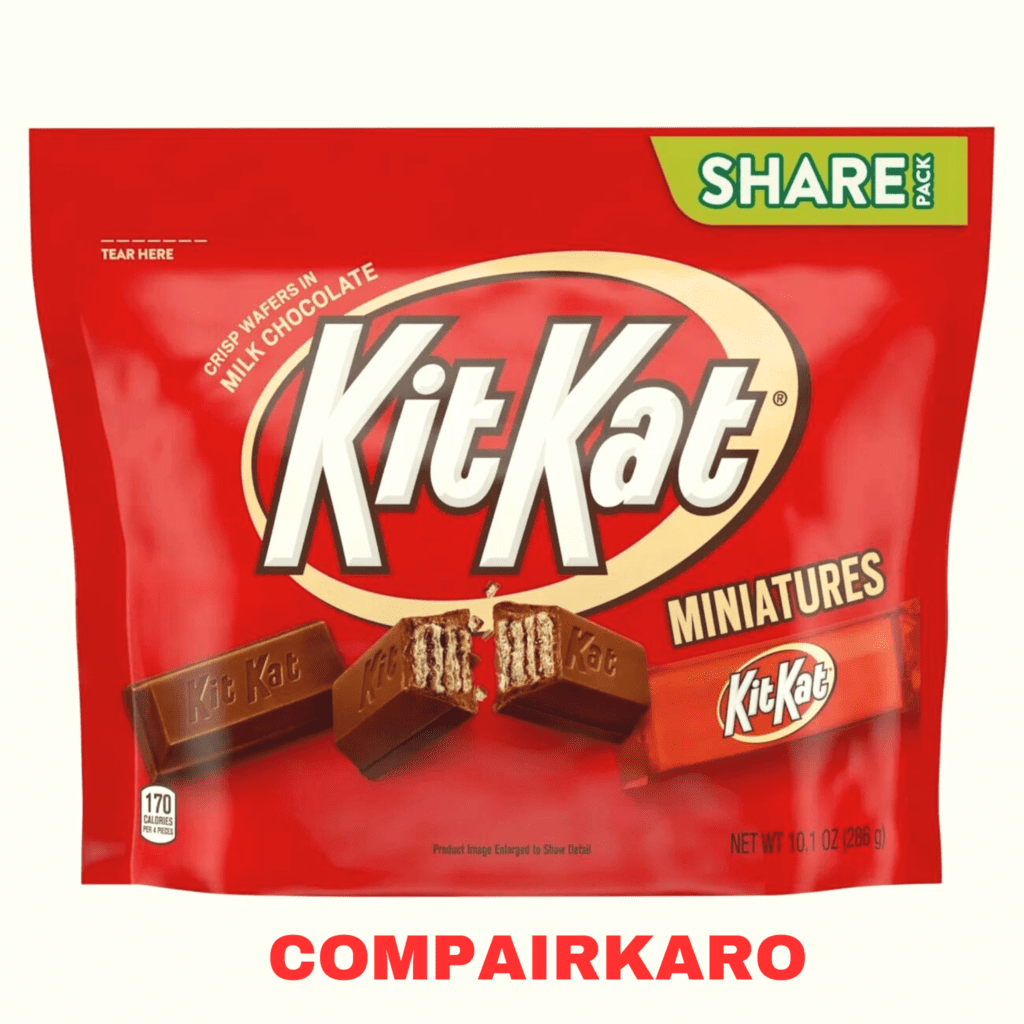
Dairy Milk :
- Cadbury Dairy Milk’s branding and packaging evoke a spirit of tradition and indulgence, in line with its reputation as a beloved classic. The brand’s visual appeal is characterized by its iconic purple wrapping, a color that has become synonymous with Cadbury chocolate. The deep purple color evokes a sense of luxury and sophistication, luring consumers in for a premium chocolate experience.
Similar to KitKat, the packaging prominently featured the Cadbury logo and the “Dairy Milk” brand name, ensuring instant brand recognition. The classic glass of one and a half glasses of milk with milk flowing at the front, emphasizes the brand’s emphasis on using high quality milk in chocolate, assuring consumers of its creamy and delicious taste.
- The packaging of Cadbury Dairy Milk evokes a sense of familiarity and warmth, evokes nostalgia and evokes memories associated with the brand. The deep purple color, along with the brand’s iconic logo, instills a sense of trust and reliability, as consumers know they are choosing time-tested and favorite chocolate.
- Dairy Milk’s attention to detail and presentation improves the overall consumer experience. The smooth and velvety texture of the chocolate is reflected in the luxurious purple packaging, which promises a luscious and indulgent taste. The tradition and sense of quality associated with the brand’s packaging reinforces Cadbury’s position as a favorite household name and preferred choice for chocolate lovers around the world.
Comparison
- Both KitKat and Cadbury Dairy Milk have carefully crafted their branding and packaging to appeal to consumers in different ways. KitKat’s vibrant red packaging communicates energy and excitement, emphasizing the interactivity of individual finger breaks and encouraging a fun and enjoyable chocolate break experience. On the other hand, Cadbury Dairy Milk’s deep purple wrapping evokes tradition and a sense of indulgence, assuring consumers of the brand’s commitment to quality and the deliciously creamy taste of chocolate.
Ultimately, both the branding and packaging of chocolates have contributed to their enduring popularity, creating positive emotions and associations with each delightful bite. Consumers can easily recognize and connect with these beloved chocolate bars, making them an all-time favorite in the confectionery world.
7. Market Presence and Availability
KitKat and Dairy Milk, as iconic chocolate brands, enjoy a strong market presence and are widely available in many countries around the world. Nestlé, the company behind KitKat, and Cadbury, the brand owner of Dairy Milk, have both established extensive distribution networks, ensuring that their chocolates are accessible to consumers around the world.
KitKat :
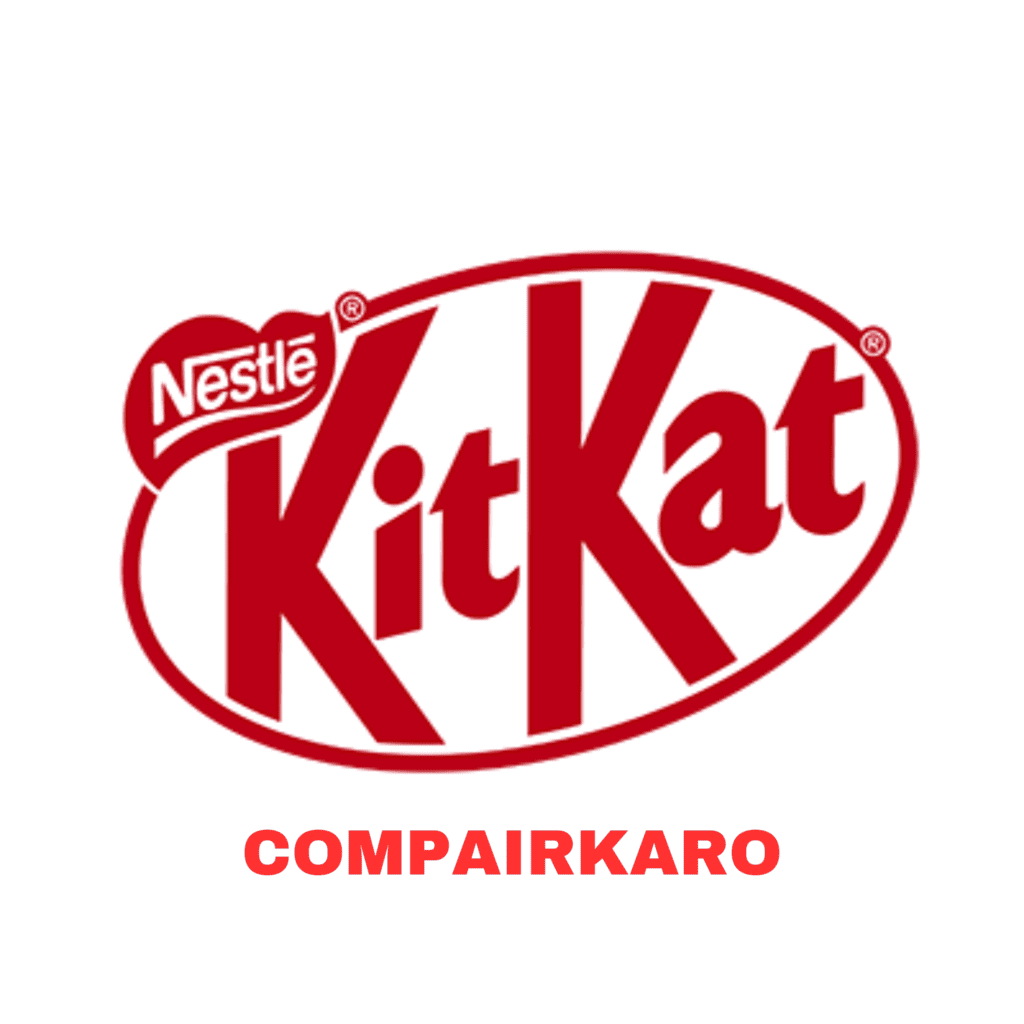
- KitKat boasts a global presence, with its popularity spanning Asia, Europe, North America, Africa, and Oceania. It is especially prevalent in Asian countries such as Japan, where KitKat has become a cultural phenomenon with a vast array of unique and seasonal flavors that cater to local tastes. In Japan, regional and seasonal variations are highly sought after, often inspired by local ingredients and cultural events. KitKat’s success in Japan may be attributed to its association with the phrase “kitto katsu”, which means “you will surely win” in Japanese, making it a popular gift to bring good luck during exams or challenges.
Dairy Milk :
- Cadbury Dairy Milk is widely available around the world, especially in countries with a historical association with the Cadbury brand. In the United Kingdom and India, dairy milk holds a special place in the hearts of consumers, where it is considered a national favourite. In India, Cadbury Dairy Milk is synonymous with celebration, especially during festivals such as Diwali, making it an integral part of cultural traditions. In the UK, Cadbury Dairy Milk has a long-standing heritage, and its marketing campaigns often evoke a sense of nostalgia, which resonates with generations of chocolate lovers.
Regional Variations:
- Both KitKat and Dairy Milk have introduced region-specific flavors to cater to local tastes and preferences. For example, KitKat in Japan offers several unique flavors such as Green Tea, Wasabi, and Sake, while in Australia, flavors such as Caramelized Popcorn and Golden Gaitime can be found. Similarly, Cadbury Dairy Milk in India offers a diverse range of flavors such as paan (betel nut), Oreo, and fruit and nut, keeping in mind the diverse culinary preferences of the country.
Comparison:
- While KitKat and Dairy Milk have a significant global presence, their regional popularity varies depending on cultural preferences and marketing strategies. KitKat’s strong presence in Japan and its wide range of Japanese-specific flavors demonstrate its adaptability to regional tastes. On the other hand, Dairy Milk’s association with cultural celebrations and its deep-rooted heritage in the UK and India have secured its position as a loved and familiar brand in these regions.
Overall, the worldwide availability and regional adaptation of both KitKat and Dairy Milk reflect their enduring appeal and versatility, making them firm favorites in the global chocolate market.
8. Cultural Significance
KitKat :
- Japan: In Japan, KitKat has immense cultural significance and has become much more than just a chocolate bar. Because of the similarity between the name “Kitkat” and the Japanese phrase “kitto katsu” (meaning “you will surely win”), the chocolate is considered a symbol of good luck, especially during times of examination or challenging circumstances. As a result, KitKats have become a popular gift among students to wish them success in their studies. Additionally, the abundance of unique and seasonal flavors offered in Japan reflects the country’s penchant for innovation and appreciation of limited-edition dishes.
Dairy Milk :
- United Kingdom: Cadbury Dairy Milk has deep cultural significance in the UK. It is associated with happy childhood memories and is often seen as a symbol of comfort and indulgence. In the UK, dairy milk has become part of various cultural traditions, especially during celebrations such as Easter and Christmas. During Easter, Cadbury Dairy Milk Easter eggs are an integral part of the Easter egg hunt and gift-giving traditions. The “Cadbury Dairy Milk Gorilla” ad, featuring a gorilla playing drums to Phil Collins’ “In the Air Tonight”, became an iconic cultural reference and resonated with the public.
- India: In India, Cadbury Dairy Milk has woven itself into the cultural fabric of festivities. During festivals like Diwali, Raksha Bandhan and Eid, dairy milk chocolates are exchanged as gifts between friends and family. Cadbury’s “Kuch Meetha Ho Jaye” campaign became synonymous with celebration and marked the nation’s sense of happiness. Furthermore, the brand’s association with India’s most popular sport cricket adds to its cultural significance.

Comparison:
- Both KitKat and Dairy Milk have adopted cultural references from different regions, contributing to their enduring popularity in diverse markets. The cultural significance of KitKat as a good luck charm in Japan reflects its ability to adapt to local customs and beliefs. On the other hand, dairy milk’s association with joyous celebrations in the UK and India reflects its role in becoming an integral part of cultural traditions. These cultural connections not only influence consumers but also contribute to the success and longevity of these iconic chocolate brands.
9. Price Comparison
Compare Prices:
KitKat and Dairy Milk bar prices may vary by country, size and packaging options. Below is a general comparison:
Kit Kat :
- KitKat is commonly available in a variety of sizes and packaging options.
- KitKat bar prices can range from low-priced single-finger bars to large multipacks.
- Price’s starting from :- Rs 5, Rs 10, Rs 20, Rs 25, Rs 30, Rs 50, Rs 200 etc….
- Individual KitKat bars are often more affordable due to their smaller size, making them a popular choice for quick and inexpensive recipes.
- Multipack options, which contain multiple fingers or bars in a single package, can provide better value for money, which makes them suitable for sharing or stocking up.
Dairy Milk :
- Cadbury Dairy Milk bars also come in a variety of sizes and packaging options.
- Price’s starting from :- Rs 5, Rs 10, Rs 20, Rs 40, Rs 45, Rs 80, Rs 85, Rs 175, Rs 180 etc….
- Dairy Milk bar prices can vary depending on the size and weight of the bar, with larger bars usually costing more than smaller bars.
- Similar to KitKat, multipack alternatives to dairy milk bars may provide better value, cater to consumers looking for larger quantities or sharing options.
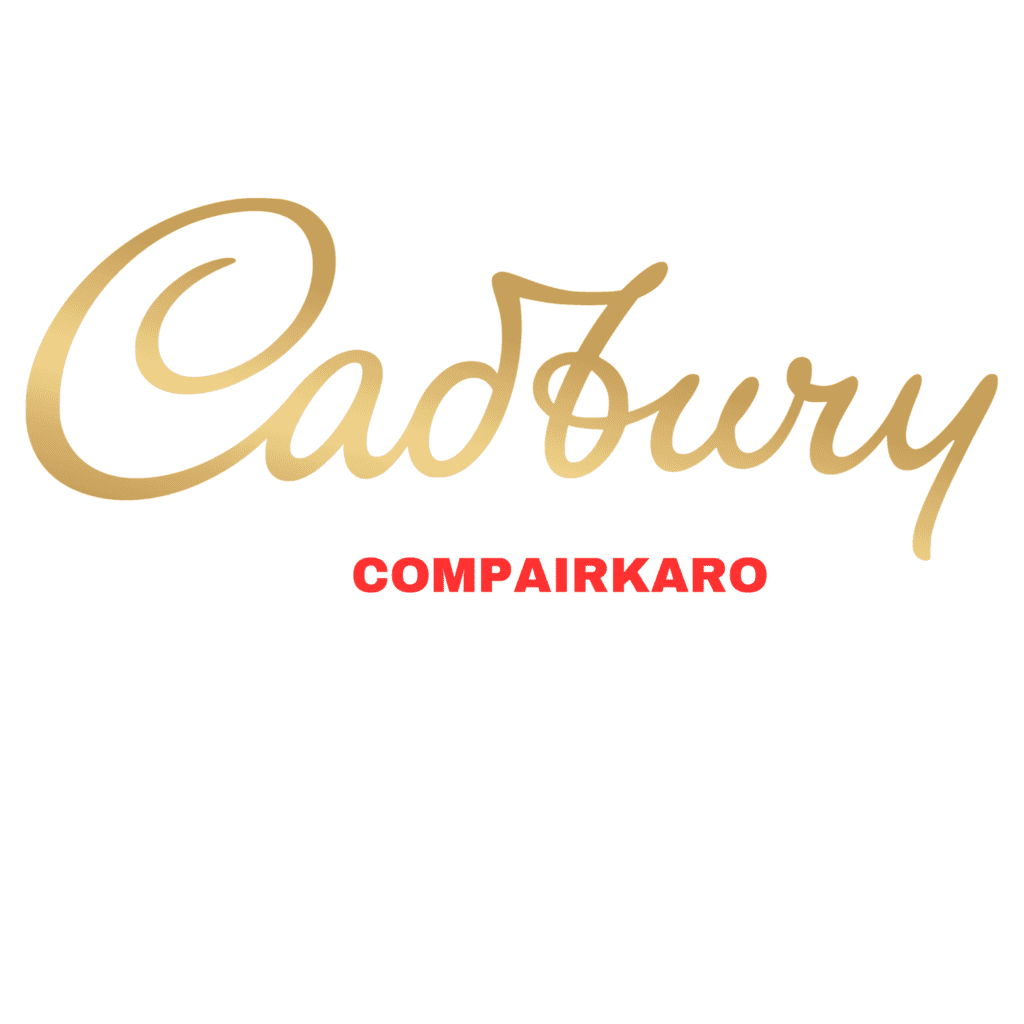
Compare:
- KitKat and Dairy Milk bar prices vary based on factors such as the size of the bar, the type of packaging, and the location where they are purchased. In some areas, the price of one chocolate bar may be slightly higher than another due to local market dynamics and delivery costs.
10. Consumer Reviews
Consumer Reviews for KitKat :
- “I love the classic KitKat! The crispy wafers and smooth milk chocolate make this such a satisfying snack. Perfect for a quick break during a busy day!” – Raj, KitKat lover
- “KitKat’s seasonal flavor is great! I tried the matcha green tea, and it was delightful. The combination of chocolate and matcha was unique and delicious!” – Ashish, The Adventurous Foodie
- “I always keep a stock of KitKats in my desk drawer. It’s a stress-reliever for me during work hours. It’s so much fun to break off a piece, and it really helps me relax.” – Anjali, Office Worker
Consumer Reviews for Dairy Milk :
- “Cadbury Dairy Milk is the ultimate comfort chocolate! The creamy texture and rich flavor takes me back to my childhood. It’s my all-time favourite!” – Rony, Nostalgic Chocoholic
- “I bought the Dairy Milk Oreo flavor, and it was fabulous! The crunchy Oreo pieces added a great texture to the smooth chocolate. Highly recommended!” – Akash, Chocoholic Foodie
- “Dairy Milk Silk Bubbly is my greatest pleasure! The bubbly texture makes it scrumptious. I indulge in it for special occasions.” – Rupal, Chocolate Connoisseur
11. Special Collaborations or Limited Editions
KitKat :
- KitKat Chocolate: KitKat has collaborated with various well-known chocolate manufacturers to create premium versions known as “KitKat Chocolate”. These collaborations deliver unique and elevated flavors, such as matcha-infused KitKat bars from renowned Japanese tea brands and artisanal chocolatiers.
- KitKat Senses: In some regions, KitKat has introduced the “KitKat Senses” range, which consists of small, chewy chocolates in various flavours. These small, luxurious dishes meet the needs of consumers seeking a more refined and elegant chocolate experience.
- KitKat Chunky Special Edition: KitKat has released special edition Chunky bars with creative and adventurous flavours, often influenced by popular desserts or regional flavours. These limited editions include flavors such as Cookies and Cream, Hazelnut and Mint.
Dairy Milk :
- Dairy Milk Marvelous Creations: Cadbury Dairy Milk introduces the “Marvelous Creations” range, which includes an imaginative combination of tastes and textures. This collaboration showcases innovative ingredients such as jelly beans, popping candy and gummy bears embedded within chocolate, providing a playful and delightful chocolate experience.
- Dairy Milk Silk: In India, Cadbury Dairy Milk Silk has unveiled a range of limited editions inspired by local flavors and festivals. These versions include flavors such as Silk Bubbly, Silk Oreo, Silk Fruit & Nut, and Silk Hazelnut.
- Dairy Milk with Oreo: Cadbury has collaborated with the popular cookie brand, Oreo, to create a unique blend of creamy chocolate and crunchy Oreo cookie pieces. Dairy Milk Oreo Chocolate Bars have become a favorite choice of people who enjoy the combination of chocolate and cookies.
Compararison:
Both KitKat and Dairy Milk have explored exclusive collaborations and limited editions to keep their brands fresh and exciting. KitKat’s association with chocolate manufacturers in the chocolate range and the introduction of KitKat Senses caters to consumers who are looking for an upscale and unique chocolate experience. On the other hand, Dairy Milk’s Marvelous Creations and Silk series offer playful and innovative flavor combinations, appealing to those in search of innovative and delightful taste sensations. These special editions showcase the brands’ commitment to innovation and creativity, enticing chocolate connoisseurs with each new release.
12. Conclusion
In this comparison of KitKat and Dairy Milk, we explore various aspects of both chocolates, including their history and origins, flavors and varieties, branding and packaging, cultural significance, and special associations. Both KitKat and Dairy Milk have unique properties that have contributed to their enduring popularity around the world.
KitKat’s light and crisp wafer, along with smooth milk chocolate, provides a delightful and interactive experience with its snap-and-share format. The brand’s global appeal, seasonal flavor and cultural significance in Japan make it a worldwide favorite.
On the other hand, the creamy and velvety milk chocolate of Cadbury Dairy Milk evokes a sense of comfort and nostalgia, especially in regions such as the United Kingdom and India. Its association with joyous festivities and diverse flavor combinations, such as the Marvelous Creations range, add to its appeal.
The ultimate winner between KitKat and Dairy Milk depends on personal preference. Some may prefer the fun and interactive nature of KitKat, while others may gravitate towards the creamy bliss of Dairy Milk. Both the chocolates have different qualities that cater to different tastes and occasions.
In conclusion, whether you are a fan of the crunchy crunch of KitKat or the velvety smoothness of dairy milk, both chocolates have earned their place as firm favorites in the world of confectionery, promising moments of pure pleasure with every delicious bite.
FAQ’S
Which chocolate is better Dairy Milk or KitKat?
Kitkat is most definitely better than Dairy Milk
Is KitKat healthy or not?
Kit Kat chocolates are a quick source of carbohydrate,and help ward off hunger. Since Kit Kat has layers of milky chocolate, it is high in calories and sugar content and should be eaten in moderation. Else, it may cause dental caries.
Is KitKat the best chocolate?
The chocolate covered-wafer bar beat a number of worthy contenders to the top spot in Ranker.com’s survey
Is Dairy Milk chocolate healthy or unhealthy?
High calorie and sugar content: Milk chocolate is typically high in calories, sugar, and fat, and consuming too much can lead to weight gain and other adverse health effects. In addition, the high sugar content can contribute to blood sugar imbalances and dental problems.
What are the side effects of KitKat?
It has some side effects such as Diarrhea,Abdominal pain,Abdominal discomfort,Flatulence

